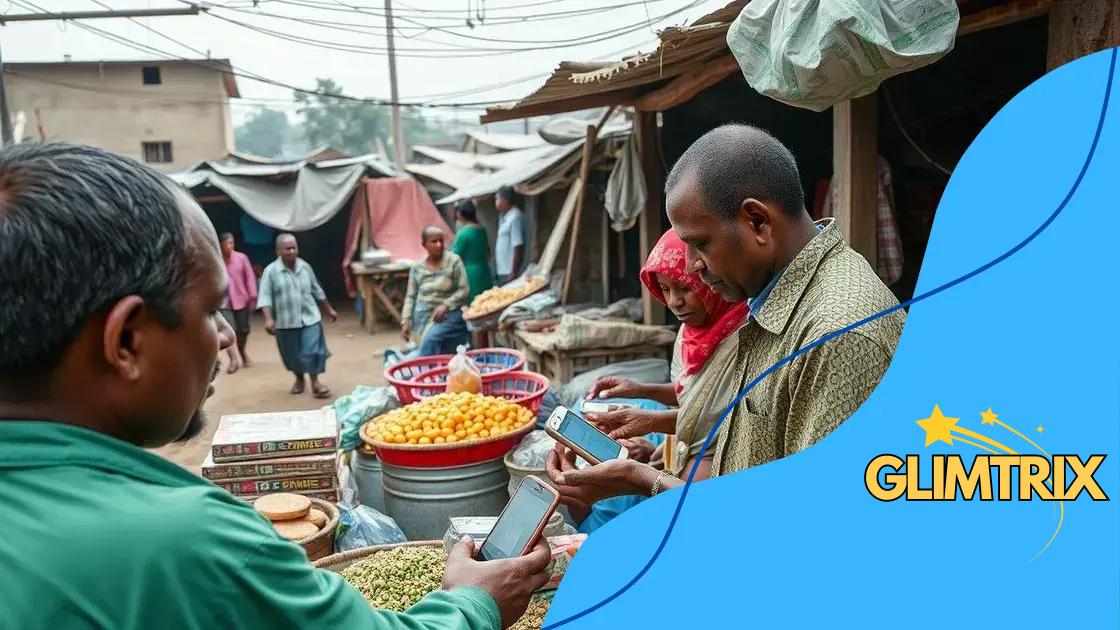Mobile payments gaining traction in developing countries

Mobile payments are gaining traction in developing countries by enhancing accessibility, boosting small businesses, and driving economic growth, despite challenges like infrastructure and security concerns.
Mobile payments gaining traction in developing countries is changing how people handle transactions. Have you ever thought about how this shift could impact daily life and economic growth? Let’s dive into this evolving landscape.
Understanding mobile payments
Understanding mobile payments is vital in today’s fast-evolving financial world. More and more people are using mobile devices for transactions, especially in developing countries. This shift is reshaping how we think about money and purchases.
What are mobile payments?
Mobile payments refer to using smartphones and other mobile devices to pay for goods and services. This method allows users to make transactions quickly and securely, often using apps or digital wallets.
Key benefits of mobile payments
There are many reasons why mobile payments are becoming popular:
- Convenience: Users can make payments anytime and anywhere without carrying cash.
- Speed: Mobile transactions are typically faster than traditional methods.
- Security: Many platforms offer advanced security features to protect user information.
As people in developing countries adopt mobile payments, it helps drive economic growth. These transactions can assist small businesses in reaching more customers efficiently. For example, a street vendor with a mobile payment option can attract more buyers.
Moreover, mobile payments enable financial inclusion. Individuals who previously didn’t have access to banks can participate in the economy. Overall, the shift towards mobile payments supports innovation and can lead to improvements in the quality of life.
Benefits of mobile transactions
Benefits of mobile transactions are numerous and significant, especially for consumers and businesses alike. The rise of these payment methods is reshaping how we think about buying and selling.
Convenience and accessibility
One of the major benefits is convenience. With mobile transactions, users can pay for goods from anywhere at any time. No need to carry cash or cards; a smartphone is all they need. This ease of access makes shopping faster and more efficient.
Speed of transactions
Mobile payments are often faster than traditional payment methods. Transactions can occur in a matter of seconds. This quick process helps businesses reduce wait times and improve customer satisfaction.
- Instant purchases: Customers can complete their orders without delays.
- Real-time notifications: Users receive immediate confirmations of transactions.
- Streamlined checkouts: Reduced friction at the point of sale.
Additionally, mobile transactions enhance security. Many platforms utilize advanced encryption to keep users’ financial information safe. Moreover, features like biometric authentication add another layer of protection. This safety makes people feel more secure when using these services.
Another important aspect is financial inclusion. In developing countries, many people do not have bank accounts. Mobile payments help bridge this gap, allowing those individuals to participate in the economy. This shift can empower small businesses, increasing their customer base and driving economic growth.
Overall, the benefits of mobile transactions extend beyond mere convenience. They support a more inclusive and dynamic economy, opening new possibilities for consumers and entrepreneurs alike.
Challenges faced in developing regions

Challenges faced in developing regions regarding mobile payments are significant and multifaceted. While mobile transactions present many opportunities, they also bring hurdles that must be addressed for widespread adoption.
Infrastructure issues
One of the main challenges is the lack of reliable infrastructure. In many developing areas, internet access is limited or inconsistent. This unreliability can hinder the ability to make mobile payments smoothly.
Financial literacy
Another obstacle is financial literacy. Many individuals might not understand how to use mobile payment systems effectively. Without proper knowledge, people may hesitate to adopt new technologies.
- Understanding different payment methods can be confusing.
- Basic knowledge of financial management is essential.
- Access to educational resources about mobile payments is often lacking.
Additionally, security concerns can affect users’ trust. Many people worry about fraud or their personal information being compromised. This fear can discourage them from using mobile payment options, even if those services are secure.
Cultural factors also influence the adoption of mobile payments. In some regions, traditional cash transactions are deeply rooted in daily life. Changing this habit can take time, as some may distrust digital transactions. Overcoming these cultural barriers requires ongoing community education and engagement.
Tackling these challenges is vital for maximizing the benefits of mobile payments in developing regions. By improving infrastructure, boosting financial literacy, enhancing security measures, and fostering cultural acceptance, more people can participate in the growing digital economy.
Case studies of success stories
Case studies of success stories in mobile payments illustrate how these technologies can transform lives and economies. Several examples showcase the positive impacts in developing regions.
Mobile payments in Kenya
One of the most notable success stories is Kenya’s M-Pesa. Launched in 2007, this mobile payment service has allowed millions of users to send and receive money using their phones. It has greatly increased financial inclusion, enabling individuals without traditional bank accounts to participate in the economy.
Impact on small businesses
Small businesses have greatly benefited from mobile payments. For instance, many vendors use mobile transaction services to expand their customer base. These services allow them to offer cashless payment options, leading to increased sales. As a result, more vendors are able to grow their businesses and support their families.
- M-Pesa users can transfer money quickly.
- Vendors report higher sales with mobile payments.
- Access to finance has improved for local businesses.
Another success story comes from Bangladesh. The mobile payment platform bKash has revolutionized the way people engage with money, especially in rural areas. Through bKash, users can transfer funds, pay bills, and even save money, all through their mobile devices.
Furthermore, this platform has provided essential services such as microloans, empowering entrepreneurs to start small businesses. These stories show how mobile payments are not just about transactions but also about economic empowerment.
The use of mobile payments is helping break down barriers and challenges in many communities. As seen in these examples, when mobile payment systems are implemented effectively, they can lead to greater financial inclusion and enhanced economic stability.
Future trends in mobile payments
Future trends in mobile payments promise to reshape how we handle transactions in the coming years. As technology evolves, several exciting developments are on the horizon.
Increased adoption of digital currencies
The rise of digital currencies, like cryptocurrencies, is influencing mobile payments. Many companies are exploring integrating blockchain technology into their platforms. This can enhance security and reduce transaction costs.
Integration of AI and machine learning
Artificial intelligence and machine learning are set to play a significant role in mobile payments. These technologies can help improve fraud detection. By analyzing user patterns, AI algorithms can flag unusual transactions quickly. This means safer mobile payment experiences for consumers.
- Personalized payment solutions will become more common.
- AI can help vendors understand customer behavior better.
- Automated customer support through chatbots will enhance user experience.
Contactless payments are also gaining popularity. With the rise of Near Field Communication (NFC) technology, users can simply tap their phones to make payments. This method offers convenience and speed, appealing to today’s on-the-go consumers.
Moreover, the focus on inclusivity will increase. More companies are investing in solutions that cater to unbanked populations in developing regions. By providing access to mobile payment options, they empower individuals and stimulate economic growth.
Overall, the future of mobile payments looks promising. Innovations in technology and a focus on user experience will drive the evolution of financial transactions. As these trends develop, more people around the world can benefit from the convenience and efficiency of mobile payments.
In conclusion, the progress of mobile payments in developing countries is reshaping financial landscapes. As we have explored, the benefits are clear—from increased accessibility to enhanced convenience. However, challenges like infrastructure and security still exist. Success stories, such as mobile payment platforms, show the positive impact they can have on communities. Looking ahead, trends like digital currencies and AI are set to further revolutionize this space. Embracing these innovations will be key to fostering financial inclusion and economic growth.
FAQ – Frequently Asked Questions about Mobile Payments in Developing Countries
What are mobile payments?
Mobile payments allow users to make transactions using their smartphones, providing a convenient and quick way to pay for goods and services.
How do mobile payments benefit small businesses?
Mobile payments enable small businesses to reach more customers and increase sales by offering cashless transaction options.
What challenges do developing regions face with mobile payments?
Challenges include limited infrastructure, low financial literacy, and security concerns, which can hinder widespread adoption.
What future trends can we expect in mobile payments?
Future trends may include the integration of digital currencies, increased use of artificial intelligence, and enhanced security measures.





